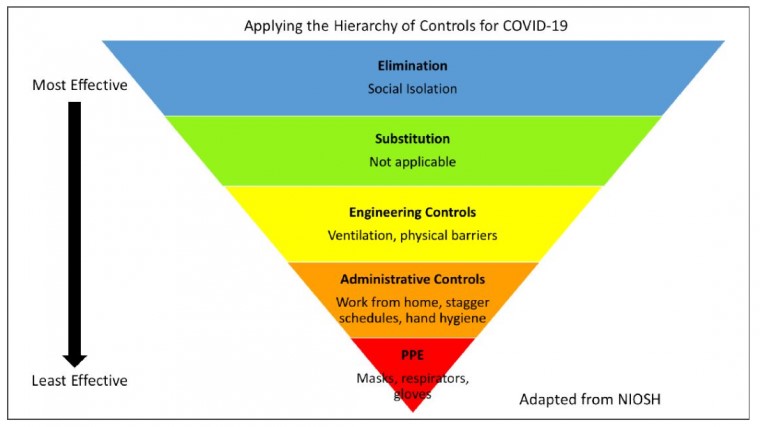As restrictions are eased and workers start transitioning back to the workplace, businesses will play a big part in helping to avoid a second wave of COVID-19 infections. They also want to be doing everything they can to ensure that when they re-open they stay open. Otherwise the cost to business and reputation is too great.
We are all being bombarded with so much information on a daily basis that it’s difficult to know where to start so this update aims to summarise the most relevant guidance material for managing your WHS obligations and to let you know where to find more information specific to your industry.
National Cabinet has released the following 10 common sense “National COVID-19 safe workplace principles” that employers can use to help them implement safe work practices in their workplaces:
1. All workers, regardless of their occupation or how they are engaged, have the right to a healthy and safe working environment.
2. The COVID-19 pandemic requires a uniquely focused approach to work health and safety (WHS) as it applies to businesses, workers and others in the workplace.
3. To keep our workplaces healthy and safe, businesses must, in consultation with workers, and their representatives, assess the way they work to identify, understand and quantify risks and to implement and review control measures to address those risks.
4. As COVID-19 restrictions are gradually relaxed, businesses, workers and other duty holders must work together to adapt and promote safe work practices, consistent with advice from health authorities, to ensure their workplaces are ready for the social distancing and exemplary hygiene measures that will be an important part of the transition.
5. Businesses and workers must actively control against the transmission of COVID-19 while at work, consistent with the latest advice from the Australian Health Protection Principal Committee (AHPPC), including considering the application of a hierarchy of appropriate controls where relevant:

6. Businesses and workers must prepare for the possibility that there will be cases of COVID-19 in the workplace and be ready to respond immediately, appropriately, effectively and efficiently, and consistent with advice from health authorities.
7. Existing state and territory jurisdiction of WHS compliance and enforcement remains critical. While acknowledging individual variations across WHS laws mean approaches in different parts of the country may vary, to ensure business and worker confidence, a commitment to a consistent national approach is key, including a commitment to communicating what constitutes best practice in prevention, mitigation and response to the risks presented by COVID-19.
8. Safe Work Australia (SWA), through its tripartite membership, will provide a central hub of WHS guidance and tools that Australian workplaces can use to successfully form the basis of their management of health and safety risks posed by COVID-19. [This is already well underway: https://www.safeworkaustralia.gov.au/covid-19-information-workplaces]
9. States and Territories ultimately have the role of providing advice, education, compliance and enforcement of WHS and will leverage the use of the SWA central hub in fulfilling their statutory functions.
10. The work of the National COVID-19 Coordination Commission will complement the work of SWA, jurisdictions and health authorities to support industries more broadly to respond to the COVID-19 pandemic appropriately, effectively and safely.
If businesses (and their officers) remain vigilant in managing risks and staying on top of current information then not only will further infections hopefully be avoided but so can more stringent measures that are being pushed by some unions eg amending WHS laws to mandate social distancing rules and other controls. The key will be acting quickly when any risks arise.
When do COVID-19 related incidents need to be reported?
Safe Work Australia has released a fact sheet setting out what COVID-19 incidents need to be notified in each jurisdiction: https://www.safeworkaustralia.gov.au/doc/incident-notification-covid-19. For example in NSW:
“PCBUs must notify SafeWork NSW of a case of COVID-19 arising out of the conduct of the business or undertaking that requires the person to have immediate treatment as an in-patient in a hospital, and any confirmed infection to which the carrying out of work is a significant contributing factor, including any infection that is reliably attributable to carrying out work that involves providing treatment or care to a person, or that involves contact with human blood or body substances.”
This is open to interpretation and may be difficult for a PCBU to know whether to report or not but it needs to be remembered that failure to comply with incident reporting obligations is an offence in itself for which both PCBU’s and their officers can be prosecuted. So erring on the side of caution is often the best policy.
COVID-19 infections in the above scenario would also potentially give rise to a workers’ compensation claim that would need to be reported separately.
What does all this mean for businesses who are slowly transitioning workers back to work?
There is not a one-size fits all solution but there is a one-size fits all approach and there are many elements that will be common to most businesses, such as:
- Keeping up extra cleaning and hygiene protocols
- Making hand sanitiser and hand washing stations readily available
- Answering simple health questions and temperature checks upon arrival
- Considering social distancing at all times
- Staggering commute times
- Staggering start and finishing times
- If you have lifts at your workplace considering how this is going to be managed
- Staggering meal and break times
- Where and how you conduct meetings
- Continuing to use working from home options whether on a rotating, semi-permanent or permanent basis especially for ‘vulnerable’ workers
- Encouraging employees to report the slightest symptoms that might be a cause for extra measures without any questions being asked
- Having a plan in place for if a COVID-19 case is reported or suspected
Another word of caution
(Practically) everyone is under financial strain but now is not the time for cutting corners or ignoring other WHS obligations. It would be easy to say that you were so focussed on managing COVID-19 risks that you didn’t have time to conduct your usual risk assessments, or times are tough so you couldn’t afford to implement some control measures that would reduce recognised risks. WRONG!
Regulators are unlikely to accept excuses like this if things go wrong. It is well established that if you can’t afford to operate your business safely then you shouldn’t be operating it. As a nation we have done so well, and we need to keep doing well to come out the other side stronger and safer than before.
We’re here to help
And remember you are not in this alone. If you can’t find the information you need in these resources then you can contact your state regulator or Safe Work Australia, or we can work through your specific scenarios with you to come up with a solution tailored to your business.
This article is for general information purposes only and does not constitute legal or professional advice. It should not be used as a substitute for legal advice relating to your particular circumstances. Please also note that the law may have changed since the date of this article.




